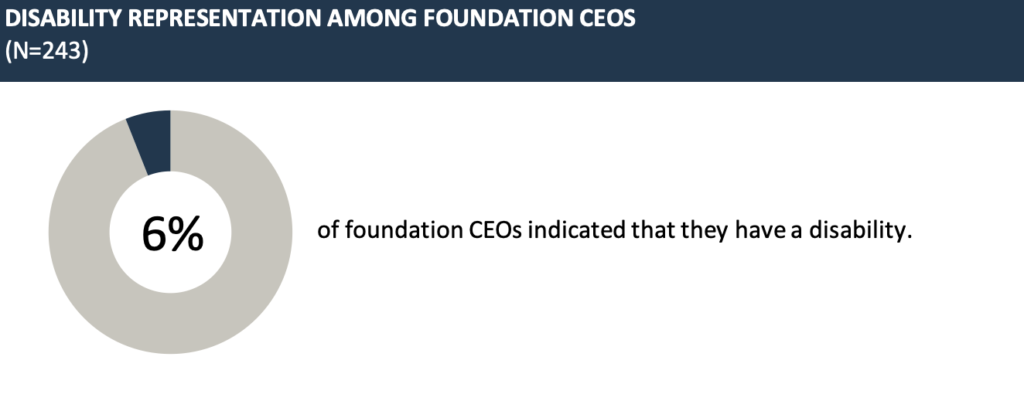In its recently released report, “Foundations Respond to Crisis: Lasting Change?,” the Center for Effective Philanthropy (CEP) shared new research in which foundations reported working differently now than in early 2020 — and indicated plans to sustain most of these changes. The report reveals numerous areas of change in foundation practice and in leaders’ plans for the future, as well as some disconnects, barriers, and additional opportunities for further change. In this series of blog posts, members of CEP’s research team will share further data and insights, beyond what was included in the report, that the research revealed. Find more posts in this series here.
Disabled people/people with disabilities — terms that I alternate throughout this blog post, recognizing that some disabled people such as myself prefer identity-first language, while other people with disabilities prefer person-first language — have disproportionately faced the devastating impacts of the COVID-19 pandemic.
Not only have we been more likely to die from COVID-19, but our deaths have also been largely dismissed, as we hear the common refrain, “Don’t worry, only disabled and elderly people are dying.” Medical ableism has resulted in us being given do-not-resuscitate orders (DNR) against our will and denied medical care. We have had challenges obtaining personal protective equipment (PPE) and COVID-19 vaccines.
Many of us who are able to work have been laid off during the pandemic. And those of us who are not able to work have struggled to live on the poverty-level income that is provided through Social Security Disability Insurance (SSDI), if we are even lucky enough to receive it.
Additionally, every issue that impacts disabled people is made even harder for disabled people of color due to the intersection of ableism and racism (in addition to the white supremacy that exists within the disability community itself).
Despite the heavy toll that COVID-19 has taken on disabled people, few foundations have increased their support for us. And perhaps relatedly, representation of people with disabilities in foundations and nonprofits is lacking.
Lack of Foundation Support for Nonprofits Serving Disabled People
Data from foundation leaders and nonprofit leaders alike indicate that few foundations have stepped up to support nonprofits that serve people with disabilities. Only 12 percent of foundation leaders say that the percentage of grant dollars they are directing to organizations serving disabled people has increased since the pandemic began.
Currently, almost two-thirds of foundation leaders say that they provide no grant dollars to organizations serving people with disabilities or that only a small percentage of their grant dollars are directed to these organizations.

In fact, in the 74 interviews that we conducted with foundation leaders during the past two years about their response to the pandemic, only one leader mentioned the topic of disability at all.
The data from nonprofit leaders are stark, too. Almost half of nonprofit leaders whose organizations primarily serve disabled people reported that no foundations provided new funding to support this community in 2020.

Lack of Disability Representation in Foundation and Nonprofit Leadership
“Nothing about us without us” is a core tenet of disability justice. No decision about people with disabilities should be made without disabled people. However, the data reveal a disappointing picture when it comes to the representation of people with disabilities in foundation and nonprofit leadership; it appears that the sector is not following this tenet.
Twenty-six percent of adults in the United States are disabled, and yet, only six percent of foundation CEOs who responded to our survey indicated that they have a disability, which suggests that disabled people are underrepresented in foundation leadership. CHANGE Philanthropy’s 2020 Diversity Among Philanthropic Professionals Report also revealed that people with disabilities are underrepresented in foundation leadership, as well as in foundation staff and boards.

Similarly, only 9 percent of nonprofit executive directors who responded to our survey indicated that they are disabled, which suggests that people with disabilities are underrepresented in nonprofit leadership as well.
What’s worse is that even when we only look at the nonprofits that primarily serve disabled people — organizations for which it is especially important to have leaders with disabilities —that percentage does not increase: only 8 percent of executive directors of these organizations indicated that they themselves are disabled.

Conclusion
Since early 2020, foundations have taken many actions to respond to crisis, but they have largely ignored disability.
This is not surprising to me, given the fact that before the pandemic, foundations and nonprofits were not doing much, if anything, to include disabled people in their work, and nonprofit CEOs believed their organizations were less diverse when it comes to disability than they were when it comes to race/ethnicity, gender identity, and sexual orientation.
But although I’m not surprised, I am deeply concerned. The need for foundations to support people with disabilities is only growing more urgent. Our community is growing rapidly as COVID-19 survivors develop long COVID, and many aspects of our lives are becoming even harder.
There is a clear need for foundations to:
- Increase their support for nonprofits that serve people with disabilities
- Increase the representation of disabled people in their leadership
- Support nonprofit leaders with disabilities
To learn more, I recommend checking out the Disability and Philanthropy Forum’s resource library.
Hannah Martin is a manager, research, at CEP. Follow Hannah on Twitter at @hannahqmartin.


